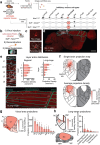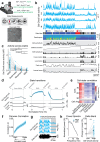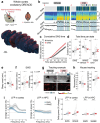This is a preprint.
Neocortical long-range inhibition promotes cortical synchrony and sleep
- PMID: 38948753
- PMCID: PMC11213009
- DOI: 10.1101/2024.06.20.599756
Neocortical long-range inhibition promotes cortical synchrony and sleep
Abstract
Behavioral states such as sleep and wake are highly correlated with specific patterns of rhythmic activity in the cortex. During low arousal states such as slow wave sleep, the cortex is synchronized and dominated by low frequency rhythms coordinated across multiple regions. Although recent evidence suggests that GABAergic inhibitory neurons are key players in cortical state modulation, the in vivo circuit mechanisms coordinating synchronized activity among local and distant neocortical networks are not well understood. Here, we show that somatostatin and chondrolectin co-expressing cells (Sst-Chodl cells), a sparse and unique class of neocortical inhibitory neurons, are selectively active during low arousal states and are largely silent during periods of high arousal. In contrast to other neocortical inhibitory neurons, we show these neurons have long-range axons that project across neocortical areas. Activation of Sst-Chodl cells is sufficient to promote synchronized cortical states characteristic of low arousal, with increased spike co-firing and low frequency brain rhythms, and to alter behavioral states by promoting sleep. Contrary to the prevailing belief that sleep is exclusively driven by subcortical mechanisms, our findings reveal that these long-range inhibitory neurons not only track changes in behavioral state but are sufficient to induce both sleep-like cortical states and sleep behavior, establishing a crucial circuit component in regulating behavioral states.
Conflict of interest statement
Competing interests. The authors declare no competing interests.
Figures




References
-
- Anafi R. C., Kayser M. S. & Raizen D. M. Exploring phylogeny to find the function of sleep. Nat Rev Neurosci 20, 109–116 (2019). - PubMed
-
- Bryant P. A., Trinder J. & Curtis N. Sick and tired: Does sleep have a vital role in the immune system? Nat Rev Immunol 4, 457–67 (2004). - PubMed
-
- Rechtschaffen A., Gilliland M. A., Bergmann B. M. & Winter J. B. Physiological correlates of prolonged sleep deprivation in rats. Science 221, 182–4 (1983). - PubMed
-
- Iwanczuk W. & Guzniczak P. Neurophysiological foundations of sleep, arousal, awareness and consciousness phenomena. Part 2. Anaesthesiol Intensive Ther 47, 168–74 (2015). - PubMed
Publication types
Grants and funding
LinkOut - more resources
Full Text Sources
